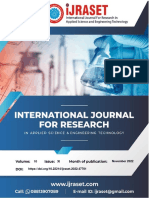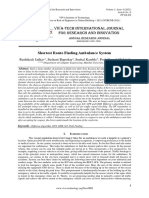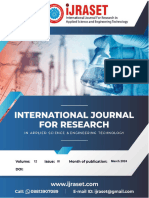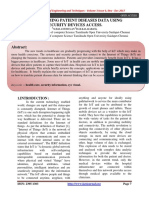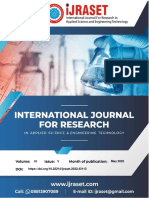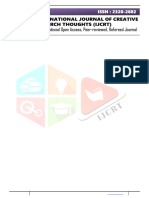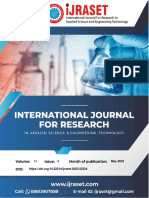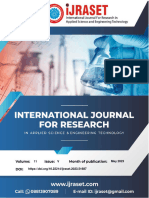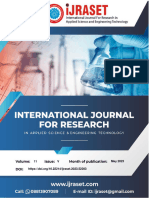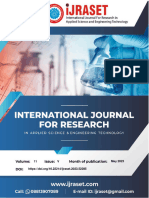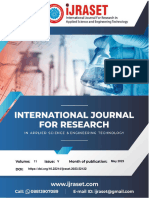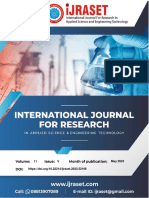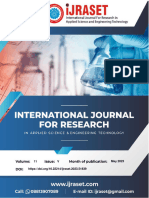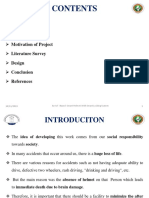Patient Health Care & Ambulance Tracking System
Patient Health Care & Ambulance Tracking System
Uploaded by
IJRASETPublicationsCopyright:
Available Formats
Patient Health Care & Ambulance Tracking System
Patient Health Care & Ambulance Tracking System
Uploaded by
IJRASETPublicationsCopyright
Available Formats
Share this document
Did you find this document useful?
Is this content inappropriate?
Copyright:
Available Formats
Patient Health Care & Ambulance Tracking System
Patient Health Care & Ambulance Tracking System
Uploaded by
IJRASETPublicationsCopyright:
Available Formats
International Journal for Research in Applied Science & Engineering Technology (IJRASET)
ISSN: 2321-9653; IC Value: 45.98; SJ Impact Factor: 6.887
Volume 6 Issue XII, Dec 2018- Available at www.ijraset.com
Patient Health Care & Ambulance Tracking
System
Renuka Bhajantri1, Pooja Chaugule2, Prasad Bhapkar3, Vishwanath Patil4, Prof. Mangal Kotkar5
1, 2., 3, 4
UG Students Department of Computer Engineering, Dhole Patil College of Engineering, Wagholi, Near Eon Free Zone Road,
Kharadi, Pune-412207, Maharashtra, India
5
Assistant Professor, Department of Computer Engineering, Dhole Patil College of Engineering, Near Eon Free Zone Road,
Kharadi, Pune-412207, Maharashtra, India
Abstract: In the Proposed system presents design of a monitoring system for emergency patient transportation. The system will
be useful for monitoring ambulance location using Google map and GPS as the Numbers of road accidents in India are the
highest across the world. To prevent this, Using advance wireless technology of GPS, it is possible to provide medical facility to
accident victim within short period of time. Continuous monitoring of ambulance location and status of patient during the
critical hour of patient transportation helps to improve medical care. One of the issues during transportation of patient is traffic
related problems. It is therefore necessary to have a fast, economical and efficient traffic control. It can display location of
ambulance and status of heart beat rate and temperature of patient. After receiving SMS hospital can prepare their staff for
proper treatment of coming patient. Proposed system track the way of ambulance coming and it makes all the signals green on
the same track after sensing the ambulance. Proposed system also stores the patient’s previous prescription information that will
help to get better treatment. Patient’s data can be fetched by using bio-metric device which will be available in ambulance
vehicles.
Keywords: Body Area Networks, Health-Monitoring, Wearable Systems, Biometric sensor
I. INTRODUCTION
The main concept behind the proposed system is to provide a smooth own for the ambulance to reach the hospitals in time and
thereby minimizing the delay caused by traffic congestion. The ARDIUNO system is used to alter the traffic lights upon its arrival
at traffic light junction which would save a lives at critical time. To avoid unnecessary traffic signal changes. In the current situation
itself, transportation of a patient to hospital in emergency conditions seems quite simple but in actual it is very difficult during peak
hours. Moreover, the situation is gets worse when emergency vehicles have to wait for other vehicles to give way at intersections
with traffic signals. As the survey aye 95% of the heart attack cases can be treated, if the ambulance can reach the hospital at current
time without stucking into the traffic. In future it may get even worse. In this cause Recovery action need to be taken immediately.
So, for our over populated environment, there is a real need for this paper for the society to make easier day to day transportations.
This paper will help to reduce blockage of emergency vehicles in traffic and helps to provide immediate recovery. Mobile app to
authenticate emergency and non-emergency conditions of ambulance. GPS to track the nearest traffic signal post to the ambulance
and to send the app data to that particular signal post. The main goal is sharing of information between patient and hospital. This
information involves patient's medical data, current condition and the most important thing location of ambulance. When the patient
or his career has exact idea when the ambulance is arriving, they can take proper action according to feedback received. Similarly if
the hospital knows when the patient is arriving, they can prepare for it efficiently. The sensor is capable of sending ambulances
location to a server, from where it can be accessed by the hospital and the patient. This is the core part of the proposed Ambulance
Tracking System (ATS), which provides real time location updates of ambulance to the hospital and to the patient who has
requested the ambulance. In addition to this, the system also provides the functionality of sharing patient's medical data with
hospital, so they can take proper measures beforehand.
II. RELATED WORK
A. A Survey On Wearable Sensor-Based Systems For Health Monitoring And Prognosis
In this paper, The design and development of wearable biosensor systems for health monitoring has garnered lots of attention in the
scientific community and the industry during the last years. Mainly motivated by increasing healthcare costs and propelled by recent
technological advances in miniature biosensing devices, smart textiles, microelectronics, and wireless communications, the
©IJRASET: All Rights are Reserved 246
International Journal for Research in Applied Science & Engineering Technology (IJRASET)
ISSN: 2321-9653; IC Value: 45.98; SJ Impact Factor: 6.887
Volume 6 Issue XII, Dec 2018- Available at www.ijraset.com
continuous advance of wearable sensor-based systems will potentially transform the future of healthcare by enabling proactive
personal health management and ubiquitous monitoring of a patient's health condition. These systems can comprise various types of
small physiological sensors, transmission modules and processing capabilities, and can thus facilitate low-cost wearable unobtrusive
solutions for continuous all-day and any-place health, mental and activity status monitoring. This paper attempts to comprehensively
review the current research and development on wearable biosensor systems for health monitoring. A variety of system
implementations are compared in an approach to identify the technological shortcomings of the current state-of-the-art in wearable
biosensor solutions. An emphasis is given to multi-parameter physiological sensing system designs, providing reliable vital signs
measurements and incorporating real-time decision support for early detection of symptoms or context awareness. In order to
evaluate the maturity level of the top current achievements in wearable health-monitoring systems, a set of significant features, that
best describe the functionality and the characteristics of the systems, has been selected to derive a thorough study.
B. Health Monitoring And Management Using Internet Of- Things (Iot) Sensing With Cloud-Based Processing: Opportunities And
Challenges
In this paper, Among the panoply of applications enabled by the Internet of Things (IoT), smart and connected health care is a
particularly important one. Networked sensors, either worn on the body or embedded in our living environments, make possible the
gathering of rich information indicative of our physical and mental health. Captured on a continual basis, aggregated, and effectively
mined, such information can bring about a positive transformative change in the health care landscape. In particular, the availability
of data at hitherto unimagined scales and temporal longitudes coupled with a new generation of intelligent processing algorithms
can: (a) facilitate an evolution in the practice of medicine, from the current post facto diagnose-and treat reactive paradigm, to a
proactive framework for prognosis of diseases at an incipient stage, coupled with prevention, cure, and overall management of
health instead of disease, (b) enable personalization of treatment and management options targeted particularly to the specific
circumstances and needs of the individual, and (c) help reduce the cost of health care while simultaneously improving outcomes. In
this paper, we highlight the opportunities and challenges for IoT in realizing this vision of the future of health care.
C. Internet-of-Things Security : Denial of Service Attacks
Internet of Things (IoT) is a network of sensors, actuators, mobile and wearable devices, simply things that have processing and
communication modules and can connect to the Internet. In a few years time, billions of such things will start serving in many fields
within the concept of IoT. Self configuration, autonomous device addition, Internet connection and resource limitation features of
IoT causes it to be highly prone to the attacks. Denial of Service (DoS) attacks which have been targeting the communication
networks for years, will be the most dangerous threats to IoT networks. This study aims to analyze and classify the DoS attacks that
may target the IoT environments. In addition to this, the systems that try to detect and mitigate the DoS attacks to IoT will be
evaluated.
D. Hybrid GPS-GSM Localization of Automobile Tracking System.
An integrated GPS-GSM system is proposed to track vehicles using Google Earth application. The remote module has a GPS
mounted on the moving vehicle to identify its current position, and to be transferred by GSM with other parameters acquired by the
automobile's data port as an SMS to a recipient station. The received GPS coordinates are filtered using a Kalman filter to enhance
the accuracy of measured position. After data processing, Google Earth application is used to view the current location and status of
each vehicle. This goal of this system is to manage eet, police automobiles distribution and car theft cautions.
E. Smart Real-Time Healthcare Monitoring and Tracking System using GSM/GPS Technologies.
Health monitoring systems have rapidly evolved recently, and smart systems have been proposed to monitor patient current health
conditions, in our proposed and implemented system, we focus on monitoring the patient's blood pressure, and his body
temperature. Based on last decade statistics of medical records, death rates due to hypertensive heart disease, shows that the blood
pressure is a crucial risk factor for atherosclerosis and ischemic heart diseases; thus, preventive measures should be taken against
high blood pressure which provide the ability to track, trace and save patient's life at appropriate time is an essential need for
mankind. The objective of this work is providing an effective application for Real Time Health Monitoring and Tracking. The
system will track, trace, monitor patients and facilitate taking care of their health; so efficient medical services could be provided at
appropriate time.
©IJRASET: All Rights are Reserved 247
International Journal for Research in Applied Science & Engineering Technology (IJRASET)
ISSN: 2321-9653; IC Value: 45.98; SJ Impact Factor: 6.887
Volume 6 Issue XII, Dec 2018- Available at www.ijraset.com
III. SYSTEM ARCHITECTURE
The system consists of an end-to-end smart health application that can be building up from two functional building blocks. Main
function of the first building block is to gather all sensory data that are related to the person’s information by using the thumb
impression, whereas the second block functions are to store, when the ambulance is going if in case the traffic is present than
automatically signal goes blue so the ambulance can easily go to the hospital. In the proposed system it saves the patient’s time and
in some accident person body not identified in this situation by using thumb impression we can find out person information. The
function working is illustrated as, when the patient’s heartbeat rate changes badly, the Arduino which recorded all the patient’s
information, GSM shield to send an SMS message containing this information, patient ID and the location of the patient which has
been taken via GPS shield, to his doctor’s mobile phone, who -by his turn send an ambulance to the patient’s location.
Fig1. System Architecture
IV. CONCLUSION
In this paper, system will reduce accidents which often happen at the traffic signal intersections because other vehicles have to
huddle to give way to the ambulance services. The proposed system is useful for critical patient information easily find out. It
provides transportation unit information and as well as patient health information, which is useful in further emergency treatment for
doctors. The Ambulance tracking system can help in saving many lives. It can also send current location using GPS system to the
server database. The server in turn sends location and status information to the doctor.
REFERENCES
[1] Pantelopoulos and N. Bourbakis, \A survey on wearable sensor-based systems for health monitoring and prognosis", IEEE Trans. Sys., Man, and Cybernetics,
Part C: Applic. and Reviews, vol. 40, no. 1, pp. 112, Jan 2010.
[2] Moeen Hassan alieragh and Alex Page,\Health Monitoring and Management Using Internet-of-Things (IoT) Sensing with Cloud-based Processing:
Opportunities and Challenges, IEEE International Conference on Services Computing 2015.
[3] Ahmet Ar__s andSema F. Oktu g, Nesnelerin Interneti Guvenligi:Servis Engelleme Saldrlar \Internet-of-Things Security : Denial of Service Attacks".
[4] Mohammad A. Al-Khedher, Hybrid GPS-GSM "Localization of Automobile Tracking System", International Journal of Computer Science & Information
Technology (IJCSIT) Vol 3, No 6, Dec 2011.
[5] Smart Real-Time Healthcare Monitoring and Tracking System using GSM/GPS Technologies", The Master of IEEE Projects 2015.
[6] Somanath Tripathy, \Design and Evaluation of an IoT enabled Secure Multi-service Ambulance Tracking System", IEEE Region 10 Conference (TENCON) |
Proceedings of the International Conference 2016
[7] Bing-Yuh Lu and Ming-Kwen Tsai, \Distant Auscultation System for Detecting Lung Sounds of Patients on Ambulances".
©IJRASET: All Rights are Reserved 248
You might also like
- 120 Oaijse Survey On Ambulance Tracking With Patient Healthmonitoring 9Document5 pages120 Oaijse Survey On Ambulance Tracking With Patient Healthmonitoring 9Yamini MutteNo ratings yet
- Iot For Health Monitoring System Based On Machine Learning AlgorithmDocument17 pagesIot For Health Monitoring System Based On Machine Learning AlgorithmmahamoodkazishayemNo ratings yet
- Smart HealthcareDocument9 pagesSmart HealthcareRohit RajNo ratings yet
- Sensors 23 04614Document16 pagesSensors 23 04614Chiraz ElhogNo ratings yet
- Healthcare Monitoring System For Remote AreasDocument7 pagesHealthcare Monitoring System For Remote AreasIJRASETPublicationsNo ratings yet
- IOT Based Health Monitoring SystemDocument7 pagesIOT Based Health Monitoring SystemIJRASETPublications100% (1)
- CSEIT1831304Document4 pagesCSEIT1831304YogeshNo ratings yet
- Summary of The Study: Iot Based Remote Patient Health Monitoring SystemDocument5 pagesSummary of The Study: Iot Based Remote Patient Health Monitoring System03052256790No ratings yet
- Bhuiyan DesignImplementation 1669982821581 42126Document14 pagesBhuiyan DesignImplementation 1669982821581 42126SheerazNo ratings yet
- Internet Based Highly Secure Data Transmission System in Health Care Monitoring SystemDocument6 pagesInternet Based Highly Secure Data Transmission System in Health Care Monitoring SystemIJRES teamNo ratings yet
- Assignment 1Document12 pagesAssignment 1Smarika ShresthaNo ratings yet
- Shortest Route Finding Ambulance SystemDocument7 pagesShortest Route Finding Ambulance SystemVIVA-TECH IJRINo ratings yet
- Research Paper 1Document11 pagesResearch Paper 1Abhay GargNo ratings yet
- Health Monitoring System Using MicrocontrollerDocument8 pagesHealth Monitoring System Using MicrocontrollerIJRASETPublicationsNo ratings yet
- Design and Implementation of Medicine Reminder Box and Health CheckerDocument6 pagesDesign and Implementation of Medicine Reminder Box and Health CheckerIJRASETPublications100% (1)
- Ijet V3i6p2Document6 pagesIjet V3i6p2International Journal of Engineering and TechniquesNo ratings yet
- Smart HealthcareDocument6 pagesSmart HealthcarepharezeNo ratings yet
- Detection and Quantification of Exudates in Color Fundus ImageDocument4 pagesDetection and Quantification of Exudates in Color Fundus ImageIJIRAE- International Journal of Innovative Research in Advanced EngineeringNo ratings yet
- A Study On Health Care in Internet of ThingsDocument4 pagesA Study On Health Care in Internet of ThingsEditor IJRITCCNo ratings yet
- Doctor ProjectDocument66 pagesDoctor Projectسيد صادق الشاه حسينNo ratings yet
- ITSU3008 Project1 Assignment 1 Planning ReportDocument12 pagesITSU3008 Project1 Assignment 1 Planning ReportSmarika ShresthaNo ratings yet
- 103 Aniot IeeeDocument7 pages103 Aniot IeeeBhaskar Rao PNo ratings yet
- Research Paper IJRASETDocument11 pagesResearch Paper IJRASETadnanh.sepNo ratings yet
- Iot Based Health Monitoring SystemDocument13 pagesIot Based Health Monitoring SystemSamuelNo ratings yet
- Real-Time Heart Pulse Monitoring Technique Using WDocument9 pagesReal-Time Heart Pulse Monitoring Technique Using WAndreea IlieNo ratings yet
- Application of Internet of Things and Sensors in Healthcare - PMCDocument26 pagesApplication of Internet of Things and Sensors in Healthcare - PMCMohammed Mian ANo ratings yet
- (IJCST-V11I4P17) :dr. T.S.Baskaran, Mr. C. VeeraprakashkumarDocument13 pages(IJCST-V11I4P17) :dr. T.S.Baskaran, Mr. C. VeeraprakashkumarEighthSenseGroupNo ratings yet
- Author'S Copy Author'S CopyDocument5 pagesAuthor'S Copy Author'S Copyziafat shehzadNo ratings yet
- Review of IOT Based Health Monitoring SystemDocument5 pagesReview of IOT Based Health Monitoring SystemSyed Muzammil AbbasNo ratings yet
- Iot-Based Health Monitoring System For Active and Assisted LivingDocument11 pagesIot-Based Health Monitoring System For Active and Assisted Livinge-park research centreNo ratings yet
- Final ArticleDocument25 pagesFinal ArticleHamid Reza ManeshtiNo ratings yet
- 2110.04997v2Document30 pages2110.04997v2digitalromNo ratings yet
- Internet of Things (Iot) Based Health Monitoring System and ChallengesDocument4 pagesInternet of Things (Iot) Based Health Monitoring System and ChallengesVarshan kbNo ratings yet
- Health Structure Monitoring and Tracking Using WSN: Mohaneesh Mitkari & Maruti LimkarDocument8 pagesHealth Structure Monitoring and Tracking Using WSN: Mohaneesh Mitkari & Maruti LimkarTJPRC PublicationsNo ratings yet
- Pationt Monitoring SystemDocument3 pagesPationt Monitoring SystemRajeevan ArunNo ratings yet
- Applications of Wireless Sensor Networks in HealthcareDocument34 pagesApplications of Wireless Sensor Networks in HealthcaresaisreeknsNo ratings yet
- Matecconf Icmed2024 01125Document8 pagesMatecconf Icmed2024 01125Sharath M NNo ratings yet
- Patient Health Monitoring System Using IOTDocument4 pagesPatient Health Monitoring System Using IOTAnonymous CUPykm6DZNo ratings yet
- IoT Application in HealthcareDocument9 pagesIoT Application in HealthcareDimas AtmojoNo ratings yet
- E-AMBULANCE: Real-Time Integration Platform For Heterogeneous Medical Telemetry SystemDocument8 pagesE-AMBULANCE: Real-Time Integration Platform For Heterogeneous Medical Telemetry SystemNourhene EllouzeNo ratings yet
- Smart Healthcare Systems a New IoT-Fog Based Disease DiagnosisDocument13 pagesSmart Healthcare Systems a New IoT-Fog Based Disease DiagnosiskashishachitraNo ratings yet
- Digital Health TrackerDocument6 pagesDigital Health Tracker22l113No ratings yet
- Digital Hospital and Patient Monitoring SystemDocument4 pagesDigital Hospital and Patient Monitoring SystemRahul SharmaNo ratings yet
- Design and Development of Real-Time Patient Monitoring System.Document66 pagesDesign and Development of Real-Time Patient Monitoring System.سيد صادق الشاه حسينNo ratings yet
- Publication PaperDocument5 pagesPublication Papersneha priyaNo ratings yet
- Health_Trackers_in_Current_Market_A_Systematic_Review_Trends_and_ChallengesDocument6 pagesHealth_Trackers_in_Current_Market_A_Systematic_Review_Trends_and_Challengesarlinejoseph98No ratings yet
- IJCRT PaperFormat-1Document8 pagesIJCRT PaperFormat-1aishuvs6No ratings yet
- Chapter 11Document26 pagesChapter 11Ivan SatriaNo ratings yet
- V4i10201540 PDFDocument6 pagesV4i10201540 PDFRaja TamilanNo ratings yet
- Ambulance Booking Mobile ApplicationDocument9 pagesAmbulance Booking Mobile ApplicationIJRASETPublicationsNo ratings yet
- IJCRT PaperFormat-2Document8 pagesIJCRT PaperFormat-2aishuvs6No ratings yet
- Capstone BatchDocument18 pagesCapstone BatchAbhinay DameruppulaNo ratings yet
- Best JournalsDocument16 pagesBest Journalsp.maheswariopenventioNo ratings yet
- Design GPS and GSM Based Ambulance Tracking With Health Monitoring SystemDocument5 pagesDesign GPS and GSM Based Ambulance Tracking With Health Monitoring SystemKarthick MNo ratings yet
- Jeppiaar SRR Engineering College: Title: Smart Wearble Health Monitoring For Patient/Elder PeopleDocument12 pagesJeppiaar SRR Engineering College: Title: Smart Wearble Health Monitoring For Patient/Elder PeopleKurushNishanthNo ratings yet
- An IoT-Enabled Ontology-Based Intelligent Healthcare Framework For Remote Patient MonitoringDocument20 pagesAn IoT-Enabled Ontology-Based Intelligent Healthcare Framework For Remote Patient MonitoringChiraz ElhogNo ratings yet
- Research On HandmatchDocument5 pagesResearch On HandmatchIJRASETPublicationsNo ratings yet
- Nikhil EportDocument25 pagesNikhil Eportbablu mokshagnaNo ratings yet
- Systems Design for Remote HealthcareFrom EverandSystems Design for Remote HealthcareKoushik MaharatnaNo ratings yet
- Emerging Computational Approaches in Telehealth and Telemedicine: A Look at The Post COVID-19 LandscapeFrom EverandEmerging Computational Approaches in Telehealth and Telemedicine: A Look at The Post COVID-19 LandscapeNo ratings yet
- Air Conditioning Heat Load Analysis of A CabinDocument9 pagesAir Conditioning Heat Load Analysis of A CabinIJRASETPublicationsNo ratings yet
- Design and Analysis of Fixed-Segment Carrier at Carbon Thrust BearingDocument10 pagesDesign and Analysis of Fixed-Segment Carrier at Carbon Thrust BearingIJRASETPublicationsNo ratings yet
- Study and Analysis of Non-Newtonian Fluid Speed BumpDocument8 pagesStudy and Analysis of Non-Newtonian Fluid Speed BumpIJRASETPublicationsNo ratings yet
- Adsorption Study On Waste Water Characteristics by Using Natural Bio-AdsorbentsDocument6 pagesAdsorption Study On Waste Water Characteristics by Using Natural Bio-AdsorbentsIJRASETPublicationsNo ratings yet
- Study and Analysis of Non-Newtonian Fluid Speed BumpDocument8 pagesStudy and Analysis of Non-Newtonian Fluid Speed BumpIJRASETPublicationsNo ratings yet
- Se of Optimism Software To Observe Effect of Different Sources in Optical FiberDocument7 pagesSe of Optimism Software To Observe Effect of Different Sources in Optical FiberIJRASETPublicationsNo ratings yet
- Advanced Wireless Multipurpose Mine Detection RobotDocument7 pagesAdvanced Wireless Multipurpose Mine Detection RobotIJRASETPublicationsNo ratings yet
- Design and Analysis of Components in Off-Road VehicleDocument23 pagesDesign and Analysis of Components in Off-Road VehicleIJRASETPublicationsNo ratings yet
- IoT-Based Smart Medicine DispenserDocument8 pagesIoT-Based Smart Medicine DispenserIJRASETPublications100% (1)
- Role of Artificial Intelligence in Emotion RecognitionDocument5 pagesRole of Artificial Intelligence in Emotion RecognitionIJRASETPublicationsNo ratings yet
- Controlled Hand Gestures Using Python and OpenCVDocument7 pagesControlled Hand Gestures Using Python and OpenCVIJRASETPublicationsNo ratings yet
- A Review On Speech Emotion Classification Using Linear Predictive Coding and Neural NetworksDocument5 pagesA Review On Speech Emotion Classification Using Linear Predictive Coding and Neural NetworksIJRASETPublicationsNo ratings yet
- 11 V May 2023Document34 pages11 V May 2023IJRASETPublicationsNo ratings yet
- BIM Data Analysis and Visualization WorkflowDocument7 pagesBIM Data Analysis and Visualization WorkflowIJRASETPublicationsNo ratings yet
- Skill Verification System Using Blockchain SkillVioDocument6 pagesSkill Verification System Using Blockchain SkillVioIJRASETPublicationsNo ratings yet
- Topology Optimisation of PistonDocument8 pagesTopology Optimisation of PistonIJRASETPublicationsNo ratings yet
- Comparative in Vivo Study On Quality Analysis On Bisacodyl of Different BrandsDocument17 pagesComparative in Vivo Study On Quality Analysis On Bisacodyl of Different BrandsIJRASETPublicationsNo ratings yet
- TNP Portal Using Web Development and Machine LearningDocument9 pagesTNP Portal Using Web Development and Machine LearningIJRASETPublicationsNo ratings yet
- Real Time Human Body Posture Analysis Using Deep LearningDocument7 pagesReal Time Human Body Posture Analysis Using Deep LearningIJRASETPublications100% (1)
- Pneumonia Detection Using X-Rays by Deep LearningDocument6 pagesPneumonia Detection Using X-Rays by Deep LearningIJRASETPublicationsNo ratings yet
- Design and Analysis of Fixed Brake Caliper Using Additive ManufacturingDocument9 pagesDesign and Analysis of Fixed Brake Caliper Using Additive ManufacturingIJRASETPublicationsNo ratings yet
- Smart Parking System Using MERN StackDocument6 pagesSmart Parking System Using MERN StackIJRASETPublicationsNo ratings yet
- Structural Analysis of The Performance of The Diagrid System With and Without Shear WallDocument13 pagesStructural Analysis of The Performance of The Diagrid System With and Without Shear WallIJRASETPublicationsNo ratings yet
- Image Detection and Real Time Object DetectionDocument8 pagesImage Detection and Real Time Object DetectionIJRASETPublications100% (1)
- Credit Card Fraud Detection Using Machine Learning and BlockchainDocument9 pagesCredit Card Fraud Detection Using Machine Learning and BlockchainIJRASETPublications100% (1)
- Low Cost Scada System For Micro IndustryDocument5 pagesLow Cost Scada System For Micro IndustryIJRASETPublicationsNo ratings yet
- Fund Future Empowering The CrowdfundingDocument6 pagesFund Future Empowering The CrowdfundingIJRASETPublicationsNo ratings yet
- CryptoDrive A Decentralized Car Sharing SystemDocument9 pagesCryptoDrive A Decentralized Car Sharing SystemIJRASETPublications100% (1)
- Dark Store E-Commerce Website Using Sentiment Analysis PredictionDocument6 pagesDark Store E-Commerce Website Using Sentiment Analysis PredictionIJRASETPublicationsNo ratings yet
- Business Support System For Local StoresDocument8 pagesBusiness Support System For Local StoresIJRASETPublicationsNo ratings yet
- Sensing and Actuation As A Service, A Key Enabler For A New Cloud ParadigmDocument8 pagesSensing and Actuation As A Service, A Key Enabler For A New Cloud ParadigmLê Kim HùngNo ratings yet
- Chapter 2Document37 pagesChapter 2thu phanNo ratings yet
- Module 3Document5 pagesModule 3mahesh.panchal0033No ratings yet
- Fiware Ngsi ApiDocument84 pagesFiware Ngsi ApiAntonioJesúsJaraValeraNo ratings yet
- IoT Challenges Advances ApplicationsDocument437 pagesIoT Challenges Advances Applicationssmartem67% (6)
- Thesis On Quality Management SystemDocument7 pagesThesis On Quality Management Systemafjryiwkm100% (1)
- Domain 1-Information Systems Auditing PROCESS - (21%) : 2019 CISA Job Practice DetailsDocument5 pagesDomain 1-Information Systems Auditing PROCESS - (21%) : 2019 CISA Job Practice DetailsEuphemia AnumbaNo ratings yet
- ENEL Cyber Security PDFDocument49 pagesENEL Cyber Security PDFInu SamNo ratings yet
- A Blockchain-Based Architecture and Framework ForDocument12 pagesA Blockchain-Based Architecture and Framework ForMiltiadis LytrasNo ratings yet
- Sim808 Gps Module DatasheetDocument7 pagesSim808 Gps Module DatasheetDeepankur TripathiNo ratings yet
- On The Integration of Agents and Digital Twins in HealthcareDocument8 pagesOn The Integration of Agents and Digital Twins in HealthcarevikaashNo ratings yet
- UGRD-COMP6103 Current Trends and Issues Lab Quiz 1Document4 pagesUGRD-COMP6103 Current Trends and Issues Lab Quiz 1Zachry James jNo ratings yet
- Features, Challenges and Issues of Fog ComputingDocument12 pagesFeatures, Challenges and Issues of Fog ComputingMuhammad Abbas NawazNo ratings yet
- #5. Poor Iot Device Management: July 2020Document3 pages#5. Poor Iot Device Management: July 2020MigwellNo ratings yet
- Arnav SoamDocument12 pagesArnav SoamAbhishek GuptaNo ratings yet
- TPC 2Document48 pagesTPC 2Corp JayceNo ratings yet
- Iot U-IV UpdatedDocument25 pagesIot U-IV UpdatedVardhan TvkNo ratings yet
- Vehicle To Vehicle V2V Communication Scope Importa PDFDocument13 pagesVehicle To Vehicle V2V Communication Scope Importa PDFvahidinkormanNo ratings yet
- Cisco Jasper Achieving End To End Security in IoT - WP - 0Document11 pagesCisco Jasper Achieving End To End Security in IoT - WP - 0jagaenatorNo ratings yet
- Wirelss Communication Networks On Internet of ThingsDocument9 pagesWirelss Communication Networks On Internet of ThingsakashNo ratings yet
- Wireless Power Transmission For The Internet of Things (IoT)Document6 pagesWireless Power Transmission For The Internet of Things (IoT)Gokul SaiNo ratings yet
- Smart HelmetDocument29 pagesSmart Helmetsupreetha gc50% (2)
- 2023 Cloud Security Report ISC2 - FinalDocument26 pages2023 Cloud Security Report ISC2 - FinalGerald MwendwaNo ratings yet
- EMDG-C10065-02-7600 Relay Selection Guide Edition 7 ENDocument48 pagesEMDG-C10065-02-7600 Relay Selection Guide Edition 7 ENHenry Trejo JaimeNo ratings yet
- WDYM Portfolio Jan 12 2024Document45 pagesWDYM Portfolio Jan 12 2024geonyb1980No ratings yet
- 1615888543RME - Detail Syllabus PhD-2020Document28 pages1615888543RME - Detail Syllabus PhD-2020rakeshNo ratings yet
- Network Management in Organisations: Ethical Issues Associated With Various TechnologiesDocument5 pagesNetwork Management in Organisations: Ethical Issues Associated With Various TechnologiesOxford AssignmentNo ratings yet
- Gmail - Welcome To NPTEL Online Course - Introduction To Internet of ThingsDocument1 pageGmail - Welcome To NPTEL Online Course - Introduction To Internet of ThingsJyothy LakshuNo ratings yet
- Sample Question PaperDocument4 pagesSample Question Paper20IF033 Bhumi Khivasara IFNo ratings yet
- Executing IoT Processes in BPMN 2.0: Current Support and Remaining ChallengesDocument6 pagesExecuting IoT Processes in BPMN 2.0: Current Support and Remaining ChallengesMayur SNo ratings yet





